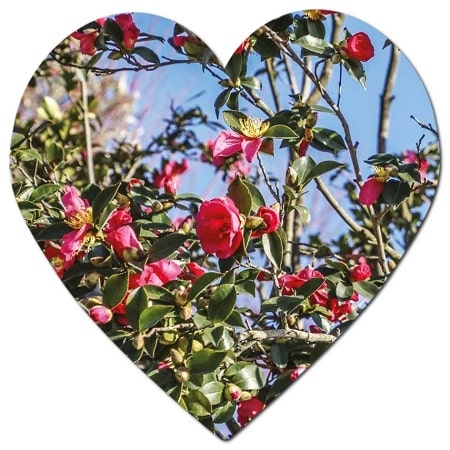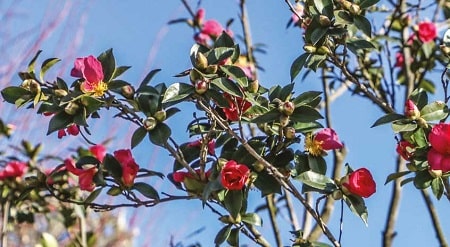It grows naturally in Japan and Korea. It is 5-7 m tall and 2.5-3 m wide. It is a densely branched upright growing tall shrub. It can be even taller in regions with mild winters and in its homeland. Evergreen, alternate simple leaves are leathery, glossy, dark green on the upper side and light green on the underside. Leaves are egg-shaped or broadly elliptic. The tip is very pointed and the base of the leaf is wedge-shaped. The leaf margin is very slightly saw-toothed. The length of the leaves is approximately 6-8 cm. Simple red flowers bloom from late February to late May.
The flowers are 3-4 cm long. Japanese Camellia grows very well in partially shaded or sunny places protected from the wind, in sandy, sandy loam, permeable and moderately less acidic soils. Measures should be taken to protect the plants from the winter sun. For this, plants are protected with reeds or straw. They are the favorite decoration elements of parks and gardens. They are used individually, in groups and in border beds. There are also varieties with especially large flowers.

Camellia japonica, commonly known as the Japanese camellia or Tsubaki, can grow in the United States. These evergreen shrubs are well-suited for USDA Hardiness Zones 7 to 9, and in some cases, Zone 6. In the United States, this includes regions of the Southeast, Gulf Coast, and parts of the Pacific Northwest.
Camellia japonica is known for its attractive, glossy foliage and beautiful flowers, which can be white, pink, red, or variegated. They prefer well-drained, slightly acidic soil and partial shade. Camellias can be grown in gardens, landscapes, and even as container plants. If you’re interested in growing Camellia japonica in your area, it’s advisable to check the specific climate conditions and hardiness zone of your location to ensure successful cultivation.
Where does Camellia japonica grow in the US?
Camellia japonica is well-suited for USDA Hardiness Zones 7 to 9, and in some cases, Zone 6. This means it can thrive in the southeastern United States, including parts of the Atlantic Coast, Gulf Coast, and some areas of the Pacific Northwest. Here are some specific regions where Camellia japonica is likely to grow well:
- Southeastern United States: Camellia japonica is commonly cultivated in states such as Georgia, Alabama, Mississippi, Louisiana, Florida, South Carolina, and parts of North Carolina and Tennessee.
- Gulf Coast: The mild climate of the Gulf Coast, including states like Texas, Louisiana, Mississippi, Alabama, and Florida, is conducive to the growth of Camellia japonica.
- Pacific Northwest: In the Pacific Northwest, particularly in parts of Oregon and Washington with milder winters, Camellia japonica can be successfully grown.
It’s important to note that within these regions, the specific microclimates and local conditions can vary, affecting the success of growing Camellia japonica. Additionally, while these are the primary regions where it is commonly grown, gardeners in other areas may also have success with proper care and attention to the plant’s needs. Camellia japonica in America >>
How to care for the Camellia japonica rose in America
Camellia japonica, commonly known as Japanese camellia, is a beautiful evergreen shrub that requires specific care to thrive. Here are some general guidelines for caring for Camellia japonica in the United States:

- Planting:
- Choose a well-draining, slightly acidic soil. Camellias prefer soil with a pH between 5.0 and 6.0.
- Plant in a location with partial shade, as they generally do not tolerate full sun exposure.
- Watering:
- Keep the soil consistently moist, especially during dry periods. However, make sure the soil is well-draining to prevent waterlogged conditions.
- Mulching:
- Apply a layer of mulch around the base of the plant to retain moisture, suppress weeds, and regulate soil temperature. Use an acidic mulch like pine straw or pine bark.
- Fertilizing:
- Feed Camellia japonica with a balanced, acid-forming fertilizer. Apply in spring before new growth begins and again in late summer.
- Avoid using lime around camellias, as they prefer acidic soil.
- Pruning:
- Prune after the flowering season to shape the plant and remove dead or diseased branches.
- Camellias generally require minimal pruning, but regular maintenance helps to maintain a healthy and attractive shape.
- Protection from Extreme Weather:
- Protect the plant from harsh winter winds, as cold, drying winds can damage the foliage.
- In areas with severe winters, consider covering the plant with burlap or providing other forms of winter protection.
- Pest and Disease Control:
- Keep an eye out for pests like aphids, scale insects, and spider mites. Treat infestations promptly.
- Camellias can be susceptible to diseases such as camellia leaf gall and root rot. Ensure good air circulation and well-drained soil to minimize the risk.
- Winter Care:
- Water the plant well in the fall before the ground freezes to help prevent winter damage.
- In colder climates, consider applying a thick layer of mulch around the base to protect the roots from freezing temperatures.
Remember that specific care requirements may vary based on your local climate and conditions. It’s always a good idea to monitor your plants regularly and adjust care practices accordingly.
Camellia japonica rose prices in America
Camellia japonica, commonly known as Japanese camellia, is not a rose; it belongs to the camellia family. Prices for Camellia japonica plants in the United States can vary depending on several factors, including the size of the plant, its age, and the nursery or garden center where you purchase it. Additionally, factors like the plant’s variety and whether it’s in bloom can also influence the price.
As of my last knowledge update in January 2022, small Camellia japonica plants might start around $20 to $30, while larger, more mature specimens or rare varieties could be priced significantly higher, ranging from $50 to several hundred dollars.
To get the most accurate and up-to-date information on Camellia japonica prices, it’s best to check with local nurseries, garden centers, or online plant retailers. Prices can also vary by region and availability. Keep in mind that seasonal sales, promotions, and discounts may affect the prices as well. Camellia japonica rose in America >>
